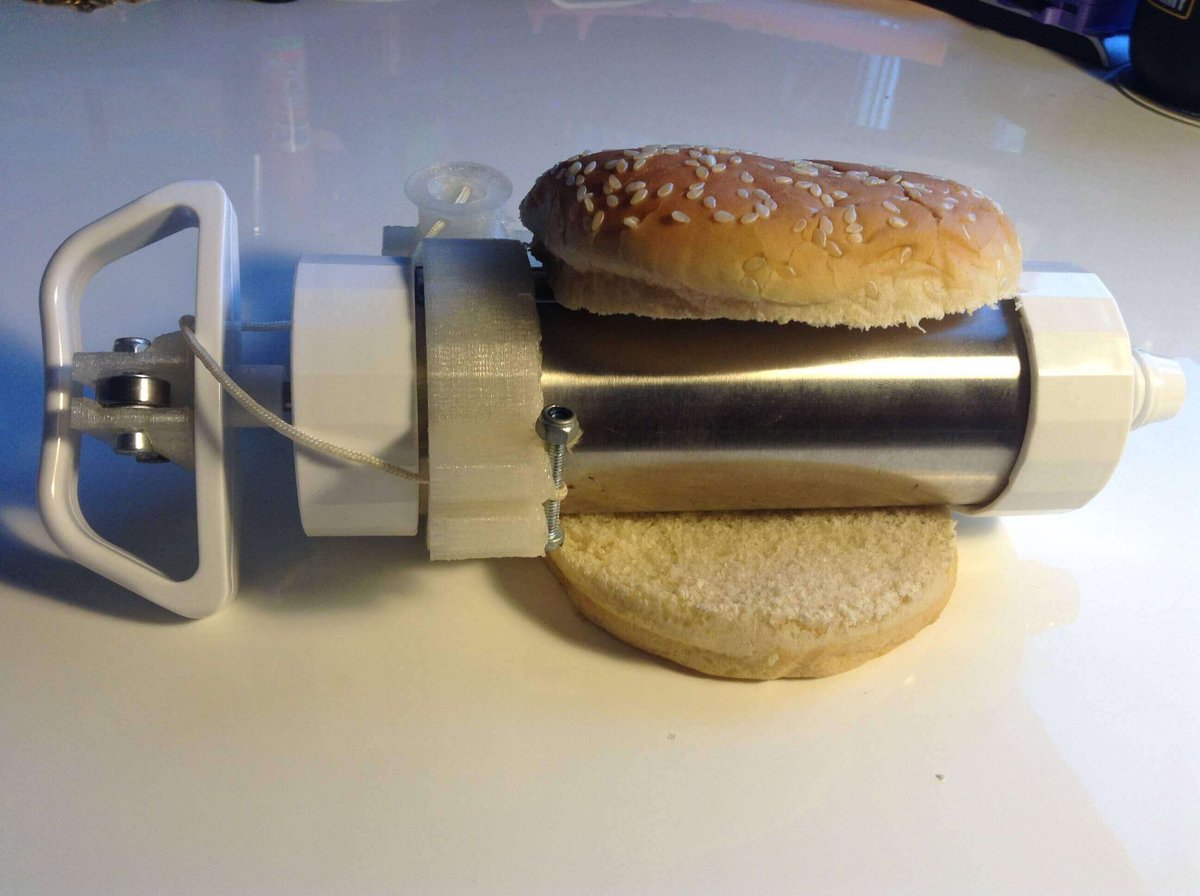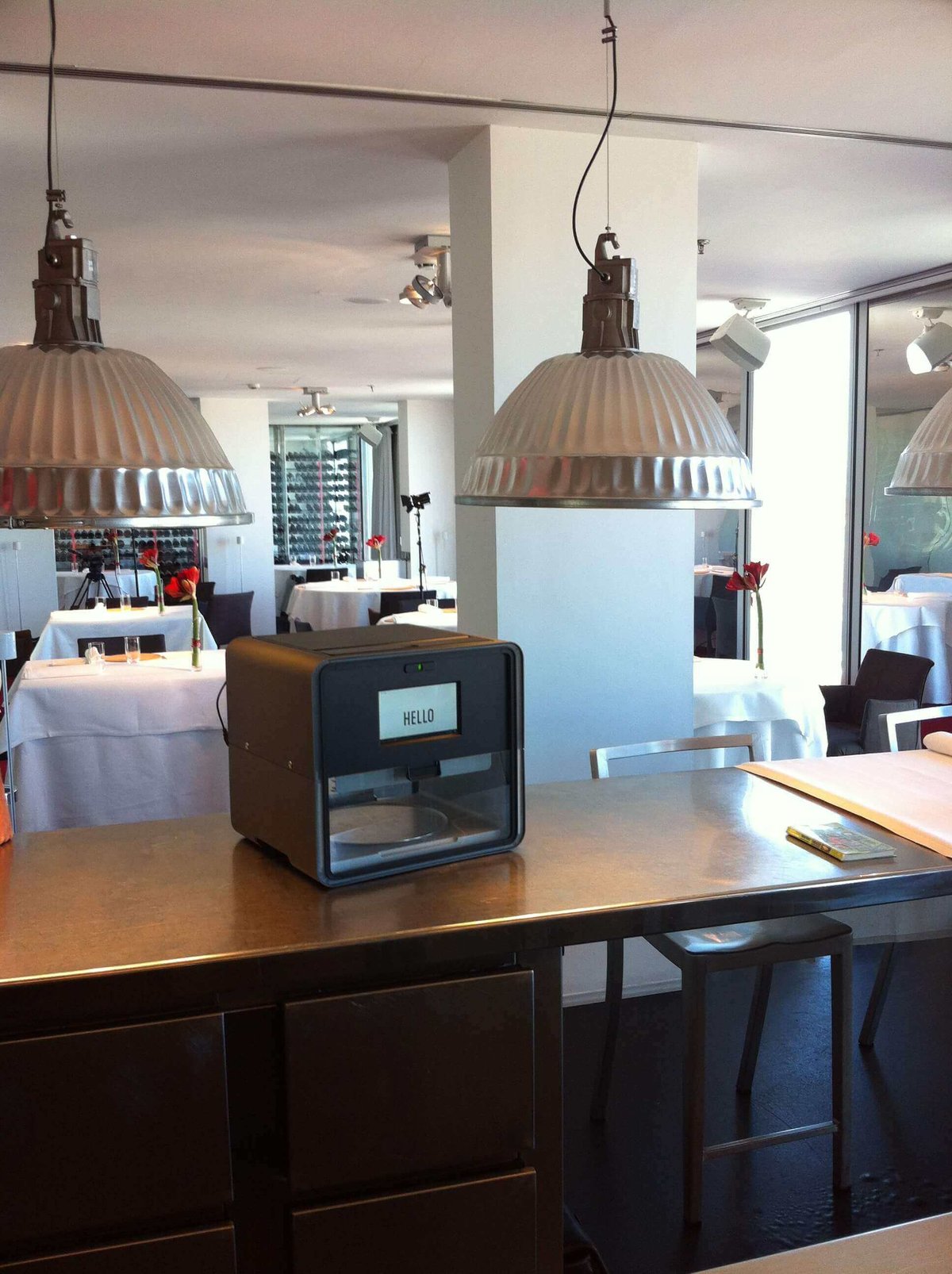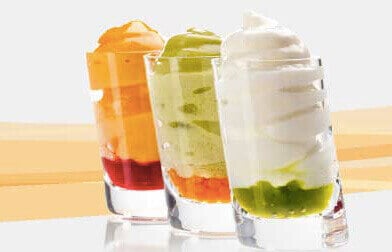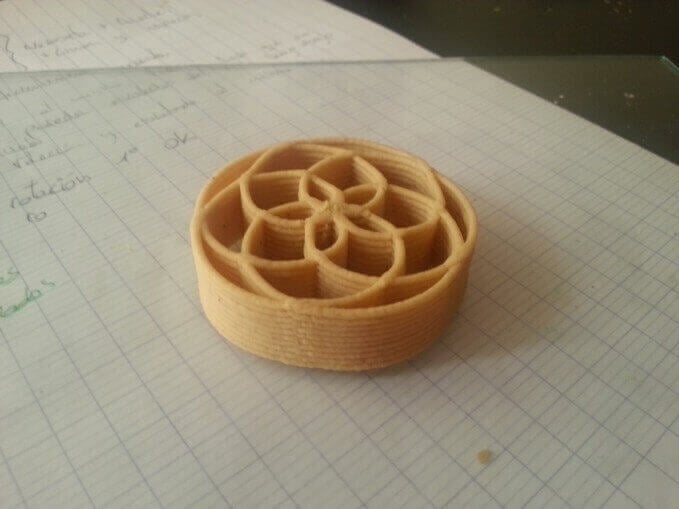Why you should read that: to get a glimpse of ways 3D food printing could potentially save us from looking for food on other planets.
Although my thoughts on this topic may be different to many others, there can be no doubt by now that low-cost 3D printing is starting to have an impact on our world. It allows people who have ideas to actually prove them. People who thought they could never get their product off the ground are now launching Kickstarter projects as fast as McDonald’s sells BigMacs. The question of “is 3D printing a fad?” is no longer in anyone’s thoughts and only “where will 3D printing go from here?” is being asked and talked about. For me this is an easy answer: EVERYWHERE.

Since I saw a little elephant appear basically out of thin air at HackerspaceFFM a few years ago that was printed for me by Marcus Link (@Manupool), I have known it was going to be BIG. But I had no idea that it would have such a big impact on my life after only 1 year of owning my own 3D printer. Although it has also caused a decent amount of stress and hair loss for me it has all been worth it. I am able to do all kinds of things that I only would dream about before; print “Barbie-like” (have to be careful and put the “like” in there) accessories for my daughter, make all those ideas I’ve got stashed in a shoebox come to life and create and customize almost anything that I want to.
I now not only think about how many cool plastic things I can print, but more about what I can improve and how I can make things more efficient or effective, ANYTHING. I do not only do this with my own designs. I’ve been looking at almost everything this way. My uncles were always tearing stuff apart so I am guessing a little of this way of thinking came from them. But I know that mostly I think this way because of 3D printing and the RepRap project. So out of this same way of thinking I know it is already being talked about, researched and studied… How can 3D printing food impact us? Can 3D food printing help us?
Can 3D printing food save the world? (Dun-Dun-Duuuuun!)
I asked myself this question and of course did a little research on this topic to come up with some ways that I believe and know how 3D food printing will have an impact on earth, our future, and humanity in general. Some of these things are already taking place, and some may seem a little out in the future but most will happen sooner than later as the #3DPrintedFood hashtag is cruising along every day, and you know about what happens to hashtags after a while right…. (cue bad joke sound here). So I hope only to invoke some conversation on this topic and maybe even inspire someone to take this discussion even further and possibly act on it as well. I am doing so with the BotBQ, but in a little less lifesaving way.
Ways 3D food printing WILL save the world
Feed people who may not have the capability to cook or feed themselves

There are many disabilities and diseases that people have that do not allow them to have the joy of cooking for themselves, and in some extreme cases even feed themselves. Printing their food may have a huge impact in this area as it may allow the people who need help in these areas normally to not need it any longer. Perhaps a food printer that also cooks the food to the specified temperature and then automatically shoots the food onto a plate.
Alternatively, a 3D food printer doesn’t have to look like the
Shapes and consistencies of food that are easily eaten and digested
I can tell you from close experience that my grandmother (who passed late in 2013) could have benefited greatly from having custom food. I remember when I was young and she would cook all kinds of good stuff. But as she aged (beautifully btw) and especially after battling and beating cancer she wasn’t allowed to eat whatever she wanted and couldn’t enjoy those huge beef ribs as often as she wanted, nor could she chow on a thick T-Bone like she used to. This eventually led to her just not cook at all… sadly she and my grandpa were stuck eating bland microwave dinners and anything fast that didn’t take much effort from grandma in the kitchen. Occasionall,y she would get some Arby’s sandwiches or some Subway that grandpa could enjoy as well.
What if she could be eating and tasting a T-Bone that was just a tad softer and easier for her stomach to process? What if those beef ribs weren’t so chewy and a little lighter for her to hold than for her to pretend she was living in the Stone Age swinging dinosaur rib bones all over the place? I have no doubt that in the future people will be able to eat almost anything customized to their specific needs. I just wished it had been possible a few months back in the past.
Upping the nutritional value of regular food

No longer will bodybuilders need to eat 6kg of tilapia every day! Obviously we need to make sure our bodybuilders no longer need to eat bland food over and over again, right?
Ok, ok… bodybuilders may play a part in 3D food printing but we won’t get into that here. Adding specific nutritional ingredients and supplements to food will also be a big part of 3D printing food very soon in the future. Using my late grandma as an example again,: She used to drink those tiny shakes that start with a P all the time…. PediaSure! I would catch her drinking those all the time, but she had to because she just wasn’t eating enough of the right kind of food to get enough protein and other vitamins in her daily consumption that she needed. She had to supplement it with these small yogurt-drink things. I’m all for supplementing your diet, if you have to but what if she had a “3D food pre-SCRIPT-ion” that just ran when she went to her food printer in her kitchen, chose what kind of food she wanted and printed out a meal with the specific dietary needs that her nutritionist and doctor agreed to…. And, BAM!, out comes a meal that looks like a steak, chews like a boiled carrot, but has the nutritional value of a protein shake and a baked potato! Also what if you could inject your kids French fries with the vitamins from broccoli and spinach?
Meals with medicine in them
Not only would this allow people to have 3D printed brownies like never before: It would solve the biggest problem of having to swallow massive amounts of pills throughout the day and getting some injections; it would even reduce the number of trips we have to make to our doctor. Now I’m sure the medical insurance industry won’t let us get away from not having to go to our doctors at all, as they would lose some revenue. But if we could save a couple trips a year, or for the people who go on a weekly basis maybe save them a couple trips a month, it would make a huge difference. Besides the fact that these older guys getting their blood drawn by some younger nurse that they could flirt with, it would give them less to complain about while at the barber shop or chatting on the ’32 Ford forum.
Having food printed that fits your exact dietary needs

Extra protein, more of a specific vitamin or ingredients that are customized to fit your blood or body type, age or whatever other factors come into play. Maybe your body runs through calories like the Seahawks Defense ran through the Denver Broncos in the Super Bowl last year, you could customize your meal with a specific amount of whatever you need to make up the difference that you would normally burn through the day in your meals.
Growing meat in a lab instead of on a farm
Not to put the farmers out of business, but to help in areas where meat may not be available. I am not about putting people out of business at all (except for the bad guys) but when this day comes I do fear for our farmers and what may happen when herds of wild cattle are roaming the plains once again. What about the pigs, chicken, giraffes! This day is already here and it is moving rapidly. Now that Google money is behind it I am sure they are already planning ways to build a 3D printing drone with AI that will be 3D printing the food to feed their army of robots when they launch their world takeover coming up before too long.
It will be so that meat will not come from killing an animal. It may not look like regular ground beef when it is made, but once it is processed through a 3D printer to look like whatever we want it to look like. Then there will be basically no difference at all, well hopefully the price will be a little different at least.
Save money on shipping food around the globe
One big advantage that is easy to see: Getting food to areas without a local shipping hub that is not normally available to them. Shipping powders or compounds for printing food would reduce costs a lot. And when you put a 3D food printer in a far-out place up in the mountains of a rain forest where there are some scientists doing research and it’s a three day hike into town to pick up the mail…., it will make a big difference for them. The more so for the rural population who have to travel that far to get their supplies. What is needed:
* Teaching people to use items that are found locally by creating catalogs of items found per region, and where to find them, that could be used in 3D food printing. Also, teaching people how to cultivate and grow “things” or food that can also be used in 3D food printing.. worms, crickets and “other” 😉
* Education will be KEY in this factor… overall education and FREE education and making sure it is made available and given to people who could use it and teach it to others is very important. We can’t hog all this 3D food printing goodness for ourselves…TEACH ALL THE PEOPLE!
Reduced cooking time

Not really sure if this is a strong hitting point, but it just popped into my head that I DO know some people who want their food when they want it and there are absolutely no questions… Rage is near, if they get too hungry – if you know what I mean. If the food can be partially cooked while it is being printed, and then once it hits the bed it continues to coo. Once the printing is done the food is basically cooking itself from the inside, and by the time it gets plated it’s ready to eat. Reducing cooking time might need some more thought put behind it.
Turning things into food that are not normally or easily eaten…
So there are a couple ways I like look at this one and here’s a couple examples:
* Printing some vegetables that you can never get your kids to eat into the shape of their favorite cartoon character or stuffed animal
You could also take some of my previous ideas and apply them here to radically adjust reality:
– Vegetable Medley that tastes and looks exactly like French Fries;
– Lentil Soup that looks and tastes like ABC shaped Chicken Noodle Soup;
– Peas & Carrots consumed as if they look and tastes like Cheese Pizza!
* Utilizing algae and insects as food but shaped like a tasty food item that we would have no problem eating. if we knew it was a regular rib eye or burrito supreme.
No matter if you believe that 3D food printing will save us or not, we have to start looking at our nutrition in a different way NOW. What you have just read hopefully got the spark lit in your head to do just that. Unexpected things are happening to our world on a daily basis and even if it isn’t 3D printing food that saves us, we have to be responsible enough to recognize that there may come a day where nutrition becomes a much bigger problem for our world than it already is.
For me my goals have shifted for the BotBQ from: “OMG let’s PRINT BURGERS!” to: “Let’s promote the heck out of 3D food printing in hopes to inspire others!” And I really do hope that my work with low-cost open source 3D food printing ( #LCOS3DFP 4 life!) can inspire others to get involved and just maybe the BotBQ can help jolt the next Adrian Bowyer, Gina Haußge, Miguel Valenzuela or “THE Joris” van Tubregen to grab some threaded rod, a frying pan and some M4 nuts and goto town (ok, that’s shooting pretty high for a simple burger printer but you never know ;-).
I’ll close this out fast to allow for you to proceed how you wish. A wise man (named Luis Rodriguez @3DigitalCooks ) once told me “Food at its core is social, it’s about sharing and caring and giving and 3D printing food should be thought about the same way.”
Jason Ray, BotBQ.org, April 2015
License: The text of "Can 3D food printing save the world?" by All3DP is licensed under a Creative Commons Attribution 4.0 International License.
